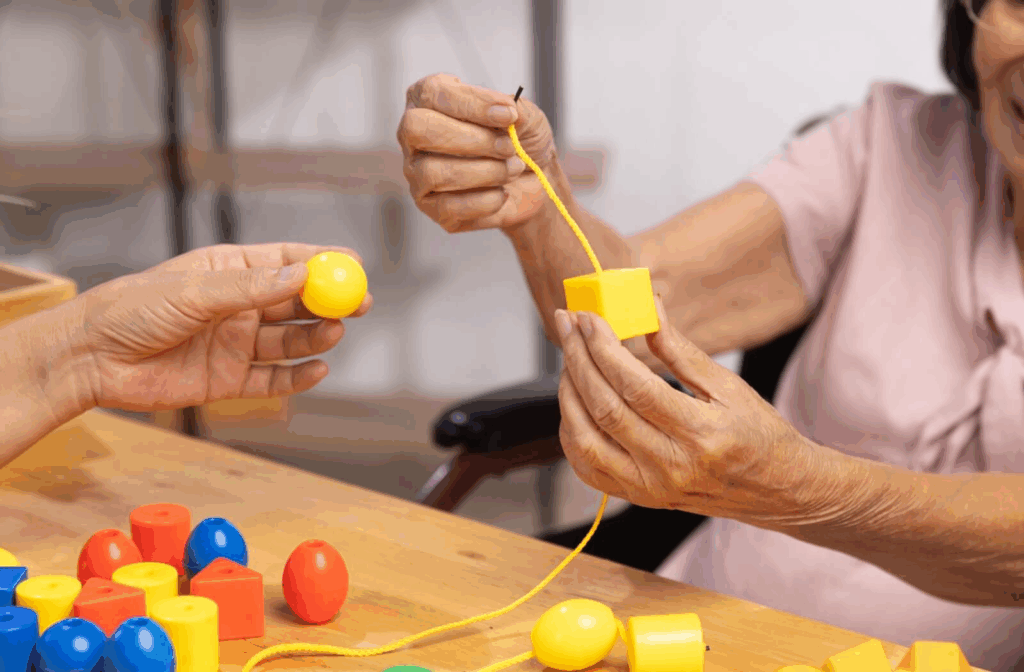Key Takeaways
- Dementia isn’t one disease—it’s an umbrella term with different causes and care needs.
- The 4 main types are Alzheimer’s disease, vascular dementia, Lewy body dementia, and frontotemporal dementia.
- Symptoms can overlap, but patterns offer clues—like memory loss appearing first vs. behavior changes appearing first.
- A formal medical evaluation is essential and treatment plans vary by type.
- Supportive routines, safe environments, and specialized memory care make daily life easier for everyone.
Do you ever feel like dementia is a puzzle with too many pieces? You’re not alone. Families often notice changes—misplaced keys, missed bills, mood shifts—and wonder what’s normal aging and what isn’t. Learning more about dementia in clear, everyday language can help you know what to watch for—and how a memory care community can help.
What Does “Dementia” Actually Mean, and Why Are There Different Types?
Think of dementia as a broad term for a group of symptoms that affect thinking, memory, behavior, and daily functioning. The “type” depends on what’s happening in the brain. Some forms start with memory loss, while others begin with language, movement, or behavior changes. Knowing the type helps doctors recommend the right treatments, therapies, and safety plans, and it helps families set realistic expectations.
While only a medical professional can diagnose dementia, noticing patterns can guide the conversation with your provider and speed up supportive care.
How Does Alzheimer’s Disease Typically Show up First?
Alzheimer’s disease is the most common type of dementia. Early signs often include short-term memory problems, such as repeating questions, forgetting recent conversations, or relying heavily on lists.
Over time, people may struggle with problem-solving, recognizing familiar places, or managing finances. You might also see changes in judgment, sleep, or mood.
What’s going on in the brain? Sticky protein plaques and tangles disrupt communication between brain cells. While there’s no cure, there are medications and lifestyle strategies that may slow progression or help with symptoms.
Tools like memory cueing, structured daily routines, and calm, familiar spaces make a noticeable difference. In a senior living community with memory support, staff use gentle prompts, meaningful activities, and safety checkpoints to reduce anxiety and keep the day flowing.
Practical tip: Bring a short list of “noticed changes” to doctor appointments, including when they began and how often they happen. Clear examples can streamline the diagnostic process.
What Is Vascular Dementia, and Why Do Heart and Brain Health Go Hand in Hand?
Vascular dementia is linked to reduced blood flow to the brain. It often follows a stroke or a series of small, sometimes silent strokes. Symptoms can include slowed thinking, trouble planning or organizing, and changes in walking or balance. Sometimes, memory is less affected early on than in Alzheimer’s.
Because blood vessels are involved, managing risk factors is key. Common risk factors include:
- High blood pressure
- High cholesterol
- Diabetes
- Sleep apnea
- Smoking
Families can support their brain health by encouraging regular physical activity, medical checkups, medication adherence, and heart-healthy meals. Memory care teams can help coordinate appointments, monitor changes, and support therapy goals like balance exercises or speech therapy.
Practical tip: Ask your clinician whether a cardiovascular workup or imaging (like an MRI) is appropriate, especially after any stroke-like symptoms, even if they were brief.
What Should We Know About Lewy Body Dementia?
Lewy body dementia (LBD) can look a bit like a mix of Alzheimer’s and Parkinson’s. Common early clues include:
- Visual hallucinations (often detailed and non-threatening, like seeing small animals)
- Fluctuating attention or alertness
- Movement changes, such as stiffness or shuffling
- Disrupted sleep (some people may act out dreams, which is known as REM sleep behavior disorder)
Medication sensitivity is a big deal in LBD—some antipsychotics can worsen symptoms, so it’s important to work with clinicians who know this condition well. Gentle lighting, simple visual environments, and predictable routines reduce confusion. Care teams trained in LBD watch for day-to-day fluctuations and adjust activities to match energy and focus levels.
Practical tip: Keep a symptom diary noting sleep quality, hallucinations, and times of day with better attention. These details help the care team fine-tune support.
Why Does Frontotemporal Dementia Often Start with Behavior or Language Changes Instead of Memory Loss?
Frontotemporal dementia (FTD) typically affects younger adults than other dementias, often in their 50s or 60s, though it can occur late, too. Early signs can include noticeable behavior shifts (loss of social filters, impulsivity, apathy) or language difficulties (trouble finding words, shorter sentences, or reduced comprehension). Memory may remain relatively intact at first.
Because FTD affects judgment and social behavior, families sometimes feel confused or hurt—“This isn’t like them.” Clear boundaries, safety checks around finances or driving, and structured days help. While there’s no cure, speech therapy, occupational therapy, and caregiver coaching can improve daily life. In a supportive setting, staff can offer low-stimulus spaces, consistent routines, and guidance for handling sensitive situations with grace.
Practical tip: If behavior changes are front and center—especially in midlife—ask the provider about an FTD evaluation, not only Alzheimer’s.

How Do Doctors Figure Out Which Type It Is, and What Can Families Do Next?
Diagnosis often includes:
- A detailed history from the person and family
- Cognitive testing to map strengths and challenges
- Blood work to rule out reversible issues (thyroid problems, vitamin deficiencies)
- Brain imaging to look for patterns (atrophy, strokes, or other changes)
- Sometimes sleep studies or specialized scans
Next steps usually include a care plan with medications (if helpful for the type), safety adjustments, and lifestyle supports, such as nutrition, movement, sleep, hydration, and meaningful social time. Families often find that structured support in a senior living community can reduce stress, lower risks, and restore quality time together.
What Daily Strategies Make Life Smoother for Everyone?
- Create calm routines with clear anchors: meals, light exercise, favorite music.
- Use simple cues: labeled drawers, a large-print calendar, and a single place for keys.
- Keep environments tidy and well-lit to reduce tripping hazards and confusion.
- Break tasks into bite-sized steps and celebrate small wins.
- Build a “care circle” of clinicians, therapists, and trusted community staff.
If caregiving feels heavy, that’s a signal of burnout—not a failure. Extra support can turn chaotic days into manageable ones.
When Is It Time to Consider Specialized Memory Care?
Consider a move when safety, wandering, medication management, nighttime confusion, or caregiver burnout become a pattern. Specialized memory care provides secure spaces, trained teams, and activities tailored to each type of dementia. The goal isn’t to take over—it’s to preserve dignity, comfort, and connection.
Our team at The Harper at Harmony Hills is here to help you map next steps, answer questions, and show how personalized memory care can feel warm and welcoming. Reach out to schedule a visit or request a friendly phone consultation today.


















